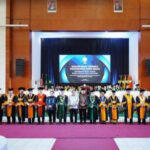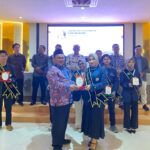Abstrak: Disertasi ini memuat konsep pengembangan model dan perancangan Sistem Pendukung Keputusan Kriteria Majemuk (SPKKM) untuk pengambilan keputusan kelompok sebagai instrumen penetapan prioritas keputusan melalui pendekatan Pengambilan Keputusan Kriteria Majemuk (PKKM).
Sebuah model pengambilan keputusan merupakan instrumen metodologik yang bersyaratkan rasional yang bertujuan untuk mengurangi resiko dan meningkatkan nilai utilitas berdasarkan data yang diperoleh. Sistematika dari perancangan model dimulai dengan penyusunan model keputusan yang dilakukan dengan cara mengembangkan hubungan-hubungan logis yang mendasari persoalan keputusan (model konseptual), kemudian dituangkan ke dalam suatu model matematis, yang mencerminkan hubungan yang terjadi diantara faktor-faktor yang terlibat.
Pengembangan model Analytic Hierarchy Process (AHP) pada penelitian ini, menghasilkan enam prinsip dalam penyelesaian masalah persoalan PKKM, yaitu: dekomposisi, penilaian perbandingan, analisis interdependensi, sintesa prioritas, pembentukkan konsensus, dan penetapan alternatif. Inti model yang dikembangkan pada penelitian ini adalah merinci suatu keadaan yang kompleks atau tak berkerangka ke dalam komponen-komponennya, kemudian mengatur bagian-bagian dari komponen-komponen tersebut dalam bentuk hirarki (dekomposisi), memberikan bobot verbal antar elemen dan menghitung bobot numerik (penilaian perbandingan), dan analisis interdependensi pada variabel yang dianggap penting (analisis interdependensi), dan selanjutnya melakukan sintesa dari pendapat tadi untuk menentukan variabel alternatif yang memiliki prioritas tertinggi (sintesa prioritas). Pada bagian akhir analisa keputusan dilakukan proses pengendaiian output dengan menggunakan model programa linier, dengan input berupa nilai dan variabel kendala (constraints) yang akan dihadapi sebagai implikasi mplementasi alternatif (penetapan alternatif). Input data untuk programa linier merupakan bentuk survai (penelusuran fakta) dalam ukuran yang operasional.
Penelitian ini mengajukan model konsensus untuk pengambilan keputusan kelompok. Metoda konsensus tersebut dapat memberikan informasi mengenai tingkat kesepakatan dan ketidaksepakatan, serta rentang ketidaksepakatan individu dan kelompok, struktur klaster, mengidentifikansi objek keputusan bermasalah dan pendapat marjinal. Pembentukkan konsesus dilakukan berdasarkan pendekatan metoda Delphi, diskusi (tukar menukar informasi) dilakukan untuk memperoleh pendapat yang homogen. Aturan penghentian diskusi dilakukan ketika dijumpai pendapat homogen yang lebih dari 66.6 persen, atau berdasarkan keterbatasan waktu. Untuk memudahkan penggunaan model ini, maka dirancang suatu SPKKM sebagai sistem yang dibangun dari model yang dikembangkan. Metodologi rancang bangun SPKKM menggunakan pendekatan top-down yang dititikberatkan pada pertimbangan kemampuan Representation, Operation, Memory, dan Control Mechanism (pendekatan ROMC) komponen SPK untuk kemudian diintegrasikan menjadi suatu sistem.
SPKKM dirancang untuk memanfaatkan analisis ilmiah pada permasalahan pengambilan keputusan, dengan tujuan untuk pengembangan dan pengelolaan sistem operasi, dan perancangan sistem informasi untuk pengambilan keputusan. Prinsip dasar bangunan sistem adalah bahwa setiap sistem diikat bersama oleh pertukaran informasi.
Abstract: This dissertation discusses the concept in the development of Multi Criteria Decision Support System (MSDSS) model and design for group decision making as a means to determine decision priorities through the Multi Criteria Decision Making (MCDM) model. A decision-making model is a methodological instrument that requires a rationale that is aimed at reducing risks and increasing utility values based on the data obtained. The systemization of model designs starts by compiling decision models that is carried out by means of developing logical relations that form the basis for the decision problem (conceptual model) to be later generated into a mathematical model which reflects the relations among the factors involved.
The development of Analytic Hierarchy Process (AHP) models in this research has resulted in six principles – in settling Multi Criteria Decision Making problems, namely decomposition, comparative judgment, interdependence analysis, synthesis of priorities, consensus-building analysis and determining alternatives.
The core of the model developed in this research is to break down a complex and unstructured condition into detailed components, and later to arrange parts of the components into a hierarchical model (decomposition), giving verbal weights among the elements and calculating the numeric weights (comparative judgment) and interdependence analysis on variables that are deemed significant (interdependence analysis), and then synthesize the ideas to determine the alternative variable with the highest priority (synthesis of priorities). At the conclusion of the decision analysis, an output control process is carried out by using a linear programming model with input in the form of constraint values and variables, which are to be faced as implication of alternative implementation (determining alternative). The data input for linear programming is the form of survey (fact-finding) within operational scope.This research puts forward a consensus model for group decision-making. The consensus method offers information concerning the level of agreement and the level of disagreement, and the range of individual and group agreement, structure of clusters; it also identifies the problematic decision object and the marginal opinions. Consensus is reached on the basis of the Delphi method approach, and discussion (information exchange) is carried out to obtain homogenous opinions. Discussion is terminated when homogenous opinions constitute over 66.6 percent, or due to time limit.
To facilitate the use of this model, a MCDSS is designed as a system built up of developed models. The design methodology of MCDSS applies the top-down approach, focused on considerations of capability of Representation, Operation and Control Mechanism (ROMC approach) of DSS components to be later integrated into one system. MCDSS is designed to benefit from scientific analyses in solving decision-making problems, with the purpose to develop and manage the operational systems as well as to design the information system for decision-making. The basic principle of system design is that each system is bound to one another by exchange of information.
The validity of MCDSS is measured on the basis of the level of usefulness, usability, capability of representation of a problematic situation, consideration of benefit-cost ratio and other important variables. The criterion of the validity of the system is based on and measured by consideration of scientific philosophy, which comprises rationalism and empiricism.
Copyrights : Copyright (c) 2001 by Fakultas Teknologi dan Industri.
Information Dissemination Right @2008 ITB Central Library, Jl. Ganesha 10 Bandung,40132, Indonesia.
Verbatim copying and distribution of this entire article is permitted by author to ITB Central
Library in any medium, provided this notice is preserved.
PhD Theses from JBPTITBPP / 2008-01-07 12:50:13
Oleh : Muhammad Ali Ramdhani , Department of Industrial Engineering
Dibuat : 2001-08-29, dengan 8 file
Keyword : Multi Criteria Decision Making ; MCDM ; namely decomposition, comparative judgment, interdependence analysis, synthesis of priorities, consensus-building analysis determining alternatives; MCDSS.
Subjek : Manajement
Kepala Subjek : Fakultas Teknologi dan Industri.
Nomor Panggil (DDC) : 658.403 RAM




















